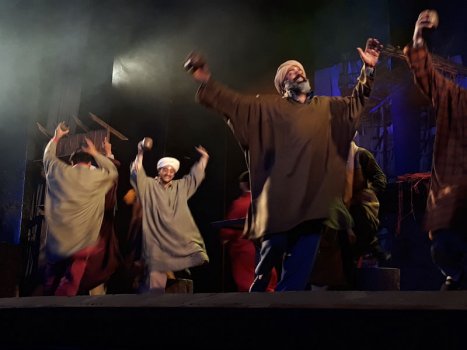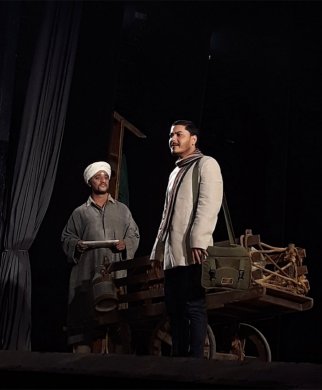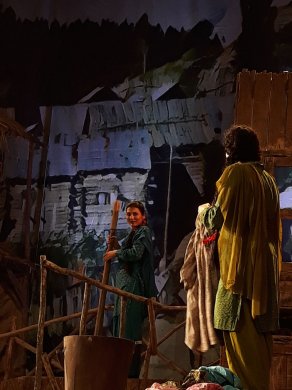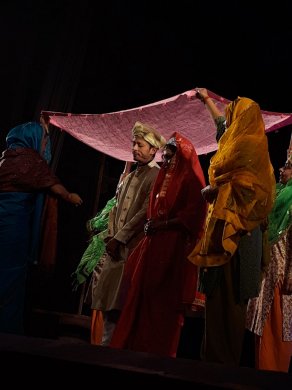
|   |

|   |
 e-mail: ukb7@rediffmail.com Colours of Kashmiriyat Photos: Abishek Ghosh January 4, 2019 Are the agonies of displacement to be experienced in perpetuity by humankind? What happens when a long-settled community of social beings are suddenly ordered out of their peaceful living environment - on grounds of ethnicity, religion, language or whatever -- and thrown to the four winds? Years of happy existence are forgotten and the simple, contented folks are suddenly made homeless, without any address and become a drifting mass of humanity, like flotsam and jetsam of the high seas! Who accounts for their uncalled-for distress and disarray? Fiddler on the Roof penned by the Jewish author Joseph Stein, is just one such saga from the beginning of the twentieth century, when Jews and Orthodox Christians lived in a nondescript little village of the pre-revolutionary Russia of the Czars. In episode after little episode, the tale of the poor dairyman and his faithful wife - with their five growing daughters - unravels how life holds for them its joy and sorrow; its rituals of orthodox matchmaking and avarice of the rich old men for the hands of the nubile maidens; its little escapades of love and amour between the indigent tailor and the dairyman's daughter, and again between the visiting student from Kiev and yet another daughter, and all hell breaking loose in the final liaison between the Christian youth and now the third daughter. 

All this is not without the humor of the dairyman asking - after 25 years of unblemished marriage - whether his wife loves him and all that she can be brought to say (after no end of coaxing and cajoling!) is, "I suppose I do..." And then the catastrophe happens. While the growing anti-Semitic prejudice seems to loom large, the remote village is caught in the whirling anti-Jewish sentiments sweeping across Europe, which drastically affect what happens to the dairyman, his family and the Jewish community in the village Anatevka as a whole. The Long March of miserable mortals begins - scurrying with bag and baggage to nowhere in particular. The theme led to a glittering Broadway musical in 1964, which went on to have an unprecedented run over 3000 shows capturing multiple Tony Awards. This was followed by its cross-Atlantic version in West End in 1967, and finally by its successful transpose on the celluloid in 1971. 

Khamoshi Sili Sili was presented on December 17 in Kolkata - featured in the Nandikar Jatiya Natya Utsav held in the Eastern capital since 1984 and reaching its glorious 34th year now - by the NSD Repertory from Delhi. A brilliant adaptation from the original by Asif Ali and directed by the veteran Suresh Sharma (heading NSD at the moment), the play captures perfectly the bonding, the bonhomie and the camaraderie of the Pandit community with their Muslim compatriots in the Valley: their seamless social cohesion, their equal participation in the spontaneous song-and-dance merriment on all occasions, till the blow strikes, leading to the miserable flow of the Pandits to unknown destinations. The highly trained actors of the Repertory do full justice to all the characters, including the specially created bit roles of the gaping village idiot, the semi-deaf elder, the voluble matchmaking spinster - who never has time to find a match for herself - and all the rest. Kashmiriyat has a legacy of centuries with the heritage of great scholars (from Bharata to Sarangadev) blended with spirituality of LalDed. Kudos are due to the director for weaving Kashmiriyat so well into the whole play, complete with its costumes, manners and customs and overarching culture, its boisterous performing arts traditions, making the agony of the minorities in the hapless state ever so poignant. The Repertory stuck to the original format of the musical, with Kajal Ghose providing melodious tunes to the lyrics, though giving them a little filmy veneer. Bansi Kaul -- the original poet of the Theatre of Displacement -- did full justice to the set, used imaginatively by Sharma in the overall design of the play. Choreography by Sikkim's Norbu Tshering was an utter delight. Although brought to Kolkata a full ten months after its opening in the national capital's Bharat Rang Mahotsav, thanks are due to Nandikar for small mercies!  Dr. Utpal K Banerjee is a scholar-commentator on performing arts over last four decades. He has authored 23 books on Indian art and culture, and 10 on Tagore studies. He served IGNCA as National Project Director, was a Tagore Research Scholar and is recipient of Padma Shri. Post your comments Please provide your name and email id when you use the Anonymous profile in the blog to post a comment. All appropriate comments posted with name & email id in the blog will also be featured in the site. |